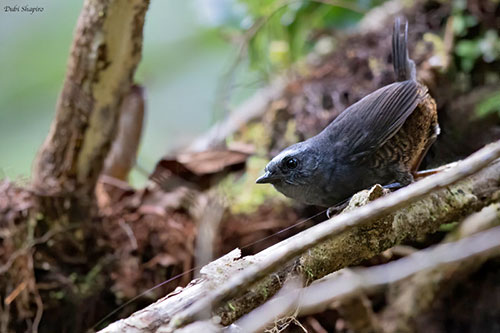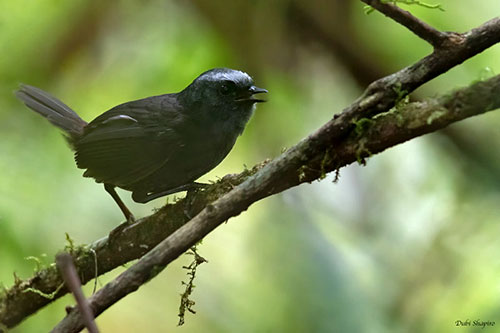
BEHAVIOUR IN THE WILD:
The Silvery-fronted Tapaculo feeds on insects, adults, larvae and pupae, and spiders. Insects include beetles (Coleoptera), earwigs (Dermaptera) and crickets. It also consumes woodlice (Isopoda).
It forages on the ground by hopping and creeping about, while searching for prey in every corner, crevices and cracks.
The members of genus Scytalopus are usually restless and fast-moving birds, although they may sometimes remain motionless for a moment in one spot.
They are often found in pairs and frequently call in duet. They are strongly territorial.
The breeding behaviour is poorly known and more information is needed.
The Silvery-fronted Tapaculo is common resident in highlands.
The tapaculos are mainly terrestrial. They fly poorly on their short wings.
REPRODUCTION OF THIS SPECIES:
An observation in Costa Rica on 7 April 2001 at 1,500 metres of elevation in the cloud forest, gives us a description of the nest.
The nest-site was about two metres from a busy trail. An adult was observed with insects in the bill, entering an inconspicuous opening in the steep slope. Tiny calls were heard inside the nest, increasing in intensity until the adult left.
The nest was at the end of a short tunnel in earth, just large enough to reach the nest. It contained two well-feathered chicks. The adults were feeding the young with arthropods every 15 minutes.
The nest was found empty on 19 April.
It was located in an area with many shrubs and small trees of various species. It was a globular structure made mainly with moss and located in a subterranean cavity at the end of a short, narrow tunnel.
Both adults probably share the nesting duties. The chicks hatch naked but they develop soon a covering of down.
PROTECTION / THREATS / STATUS:
The Silvery-fronted Tapaculo is a restricted-range species but it is described as “fairly common”. The species is present in several protected areas.
The size of the population is unknown, but it is suspected to be stable.
The Silvery-fronted Tapaculo is not globally threatened and currently evaluated as Least Concern.
Fr: Mérulaxe argenté
Ang: Silvery-fronted Tapaculo
All: Silberbrauentapaculo
Esp: Churrín Plateado
Esp: (Costa Rica): Tapaculo frentiplateado
Ita: Tapaculo fronteargento
Nd: Costaricaanse Tapaculo
Sd: gråvattrad tapakul
Photographer:
Dubi Shapiro
Dubi Shapiro Photo Galleries
Text by Nicole Bouglouan
Sources:
HANDBOOK OF THE BIRDS OF THE WORLD Vol 8 By Josep del Hoyo-Andrew Elliott-David Christie - Lynx Edicions - ISBN: 8487334504
Birds Of Central America: BELIZE, GUATEMALA, HONDURAS, EL SALVADOR, NICARAGUA - De Andrew C. Vallely, Dale Dyer – Editeur: Princeton University Press, 2018 – ISBN: 0691138028, 9780691138022 - 584 pages
First Description of the Nest of the Silvery-Fronted Tapaculo (Scytalopus argentifrons)
CREAGUS@Monterey Bay (Don Roberson)
Fatbirder - Rhinocryptidae – Tapaculos
Silvery-fronted Tapaculo
Scytalopus argentifrons
Passeriformes Order – Rhinocryptidae Family
INTRODUCTION:
The tapaculos are described as « the mice of the avian world ». They usually have cryptic plumage and are very small birds. To find them among the dense undergrowth where they forage is always a great pleasure.
The members of the genus Scytalopus are found in forest understorey or among tussocks and rocky boulders.
The Silvery-fronted Tapaculo is endemic to Panama and frequents the humid forest and adjacent second growth, from 1,000 to 3,000 metres of elevation. It may be frequently heard but difficult to see.
It feeds on insects and spiders often caught on the ground.
The breeding behaviour is poorly known, but an observation in Costa Rica allows to describe the nest, a globular structure placed in a cavity on the ground.
The Silvery-fronted Tapaculo has restricted range but it is described as “fairly common” and not globally threatened.
DESCRIPTION OF THE BIRD:
Biometrics:
Length: 11 cm
Weight: 17 gr
The Silvery-fronted Tapaculo adult male is a small bird with sooty black plumage. Wings and tail are brownish-black and the tertials are sometimes barred with rufous-brown.
The underparts are paler, especially on lower breast and belly. Flanks and vent are tawny-rufous with dark barring.
On the sooty black head, forehead and supercilium are pale silvery-grey, whereas chin and throat are paler grey.
The bill is black. The eyes are dark brown. Legs and feet are dark grey-brown.

The female resembles male but the pale supercilium is absent.
The upperparts are dark brown with dark centres to feathers, involving scaled pattern. Face, throat and breast are dark sooty grey and tinged olive-brown. The belly is blackish with broad, tawny-buff edges. Barred flanks and vent are brighter than on male.
The juvenile resembles female but the throat feathers are dull greyish-buff with dark centres, whereas rest of underparts is sooty black with buff-brown scaling.
SUBSPECIES AND RANGE:
The Silvery-fronted Tapaculo has two subspecies.
S.a. argentifrons (described above) is found in Costa Rica and W Panama (Volcán de Chiriquí).
S.a. chiriquensis occurs in W Panama in E Chiriquí and E Veraguas.
This race has sometimes been treated as a separate species.
HABITAT:
The Silvery-fronted Tapaculo is usually seen on the ground, foraging in the understorey of the humid, broadleaf forest (cloud or elfin). It frequents thickets and bamboo tangles along streams and steep hillsides near ravines.
The species is visible from 1,000 to 3,000 metres of elevation, but lower on the Caribbean slope.
CALLS AND SONGS: SOUNDS BY XENO-CANTO
The Silvery-fronted Tapaculo’s call is a repeated, sharp, metallic note “chi-chi-chi-chi” given in short series.
The song is a long, rapid series of sharp, high-pitched notes “kewkewkewkewkew…” increasing gradually in volume before to decrease from 16-17 notes to 4-7 notes per second.
Vocalizations are the best way to locate and identify the species.
